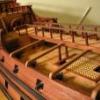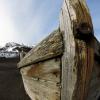-
Posts
107 -
Joined
-
Last visited
Reputation Activity
-
 bogeygolpher got a reaction from uncarina in Are those electric plank benders worth it?
bogeygolpher got a reaction from uncarina in Are those electric plank benders worth it?
I have been using my electric plank bender for over 20 years and would be lost without it. I did buy a solid state soldering iron control unit to be able to adjust the temperature. Over time i have accumulated a number of forms I use to control the shape and I have also managed to burn myself a number of times.
Not only do I use it for bending, it is quite useful as an aid for setting the PVA glue quicker. For example, when planking, I will use soak the plank and use the bender and forms to approximate the shape I want. I then coat the back of the plank with PVA as well as place some drops of CA on the frames or bulkheads where the plank will reside. Using the CA eliminates needing clamps or nails to hold it in place. Once the plank is in place I then run the bender over it to heat up the plank and speed up the drying of the PVA and getting a good seam with the plank already in place. Using that method there is no wait time between applying planks and if done carefully, it helps to eliminate a lot of the bulges and dips that seem to occur between planks.
-
 bogeygolpher got a reaction from Canada Steve in Are those electric plank benders worth it?
bogeygolpher got a reaction from Canada Steve in Are those electric plank benders worth it?
I have been using my electric plank bender for over 20 years and would be lost without it. I did buy a solid state soldering iron control unit to be able to adjust the temperature. Over time i have accumulated a number of forms I use to control the shape and I have also managed to burn myself a number of times.
Not only do I use it for bending, it is quite useful as an aid for setting the PVA glue quicker. For example, when planking, I will use soak the plank and use the bender and forms to approximate the shape I want. I then coat the back of the plank with PVA as well as place some drops of CA on the frames or bulkheads where the plank will reside. Using the CA eliminates needing clamps or nails to hold it in place. Once the plank is in place I then run the bender over it to heat up the plank and speed up the drying of the PVA and getting a good seam with the plank already in place. Using that method there is no wait time between applying planks and if done carefully, it helps to eliminate a lot of the bulges and dips that seem to occur between planks.
-
 bogeygolpher got a reaction from garym in Are those electric plank benders worth it?
bogeygolpher got a reaction from garym in Are those electric plank benders worth it?
I have been using my electric plank bender for over 20 years and would be lost without it. I did buy a solid state soldering iron control unit to be able to adjust the temperature. Over time i have accumulated a number of forms I use to control the shape and I have also managed to burn myself a number of times.
Not only do I use it for bending, it is quite useful as an aid for setting the PVA glue quicker. For example, when planking, I will use soak the plank and use the bender and forms to approximate the shape I want. I then coat the back of the plank with PVA as well as place some drops of CA on the frames or bulkheads where the plank will reside. Using the CA eliminates needing clamps or nails to hold it in place. Once the plank is in place I then run the bender over it to heat up the plank and speed up the drying of the PVA and getting a good seam with the plank already in place. Using that method there is no wait time between applying planks and if done carefully, it helps to eliminate a lot of the bulges and dips that seem to occur between planks.
-
 bogeygolpher got a reaction from mischief in Are those electric plank benders worth it?
bogeygolpher got a reaction from mischief in Are those electric plank benders worth it?
I have been using my electric plank bender for over 20 years and would be lost without it. I did buy a solid state soldering iron control unit to be able to adjust the temperature. Over time i have accumulated a number of forms I use to control the shape and I have also managed to burn myself a number of times.
Not only do I use it for bending, it is quite useful as an aid for setting the PVA glue quicker. For example, when planking, I will use soak the plank and use the bender and forms to approximate the shape I want. I then coat the back of the plank with PVA as well as place some drops of CA on the frames or bulkheads where the plank will reside. Using the CA eliminates needing clamps or nails to hold it in place. Once the plank is in place I then run the bender over it to heat up the plank and speed up the drying of the PVA and getting a good seam with the plank already in place. Using that method there is no wait time between applying planks and if done carefully, it helps to eliminate a lot of the bulges and dips that seem to occur between planks.
-
 bogeygolpher got a reaction from shoule in Sewing Ratlines
bogeygolpher got a reaction from shoule in Sewing Ratlines
HOF,
You might want to try to go through the shrouds rather than going around and trying to tie a knot.
Let me explain. In one of the many model ship building books I have read I do remember one of the authors making two points about ratlines. First is that you should use the smallest diameter thread you can find for them and second was that no matter what size thread you use, or what type of knots you tie, your knots will be way too large for scale. To address the knot issue he suggests you use a needle and sew the the ratline through the center of the shroud, gluing them in place. In other words, do not make any knots.
I did try this once a long time ago and it looked good. However, it was not easy to get the needle into the center of the shroud. Maybe magnifiers, or better eyes would have helped. I think it is easier to tie knots, but if that is proving to be impossible, you might try to sew through the shrouds.
Another alternative is to run the ratlines over or under the the shrouds and gluing them in place rather than tying them. Most craft stores have glues made specifically for gluing fabric that should work well.
-
 bogeygolpher got a reaction from marktime in Sewing Ratlines
bogeygolpher got a reaction from marktime in Sewing Ratlines
HOF,
You might want to try to go through the shrouds rather than going around and trying to tie a knot.
Let me explain. In one of the many model ship building books I have read I do remember one of the authors making two points about ratlines. First is that you should use the smallest diameter thread you can find for them and second was that no matter what size thread you use, or what type of knots you tie, your knots will be way too large for scale. To address the knot issue he suggests you use a needle and sew the the ratline through the center of the shroud, gluing them in place. In other words, do not make any knots.
I did try this once a long time ago and it looked good. However, it was not easy to get the needle into the center of the shroud. Maybe magnifiers, or better eyes would have helped. I think it is easier to tie knots, but if that is proving to be impossible, you might try to sew through the shrouds.
Another alternative is to run the ratlines over or under the the shrouds and gluing them in place rather than tying them. Most craft stores have glues made specifically for gluing fabric that should work well.
-

-
 bogeygolpher got a reaction from Landlubber Mike in plank entire second layer length with one strip?
bogeygolpher got a reaction from Landlubber Mike in plank entire second layer length with one strip?
I have done it both ways and found it much easier to shape the plank for the entire length. As was also pointed out, the width of the planks supplied in kits is not very consistent and when applying subsequent rows of planks cut to scale length it required constant adjustment in order to get a smooth line without gaps.
I agree with Chuck, score the planks to scale to simulate the length.
-
 bogeygolpher got a reaction from Mirabell61 in Coppering - Plates vs. Tape?
bogeygolpher got a reaction from Mirabell61 in Coppering - Plates vs. Tape?
Floyd,
I have used strips for two models and they are thin enough that you can overlap them.
If doing that. you want to leave one of the edges (top or bottom) smooth so you won't have rivets on rivets when applied. I personally did not like the look because I was not able to overlap the plate beside as those seams are simulated except at the ends of the tape run..
Another thing is I have found it easier to use strips no longer than about four plates long. Any longer than that and it became unruly and hard to manage on the curves. I like the look and as is pointed out it obviates the need for using CA which I try to minimize at all costs. That's not a purist reference, just my discomfort working with it. Further, the adhesive on the tape is quite good but one needs to be careful at the edges of the hull as any mishaps might pull the tape away. To prevent that, I did use a small bit of CA along the outside edges.
Which ever method one chooses make sure you get a protective coating on as soon as possible unless you want the tarnished look.
-
 bogeygolpher got a reaction from LEGION 12 in marking water line
bogeygolpher got a reaction from LEGION 12 in marking water line
Try this for an inexpensive marker.
-
 bogeygolpher got a reaction from hamilton in mamoli customer service
bogeygolpher got a reaction from hamilton in mamoli customer service
Hamilton,
I suggest you use the web site Steve provided.
Be prepared to wait a while for replacement parts from them. They will eventually ship them to Model Expo who will forward them to you.
On the Model Expo site you will find this information under their warranty/guarantee information.
-
 bogeygolpher got a reaction from thibaultron in Bend cast metal parts
bogeygolpher got a reaction from thibaultron in Bend cast metal parts
Isn't this typical? You ask about something and it almost always leads to something else.
Thank you for your answers to my question. I tried the heating thing and it did not work. I do not think I got it hot enough in the oven or in the hot water because it still snapped. To be honest, I'm not sure exactly what these castings are made of, and if it contains any lead I really do not want to raise the temperature to the melting point. So I may have wimped out in getting enough heat on the castings to be able to bend them. What I still do not understand is how the castings (railing posts) got bent in the first place without breaking. I guess it really doesn't matter because the fact is they are bent.
That said, the suggestion to make resin copies intrigues me and seems to be a great solution. I found the resin materials are available from the hobby store or on-line. What do you use to make the mold, and are there any other tricks one should know if attempting this? Is there a how to on this process somewhere?
Thanks again.
-
 bogeygolpher got a reaction from thibaultron in Bend cast metal parts
bogeygolpher got a reaction from thibaultron in Bend cast metal parts
Does anyone have any suggestions on how to bend cast metal parts?
Whenever I have tried in the past to either bend them or straighten them I managed to break them and then had to make substitutes, usually out of wood because I am much more comfortable working with wood than metal.
I hope I am using the correct terminology when I say cast metal. I am referring to the white metal parts supplied in most kits that usually have a little bit of flashing on them and are quite brittle.
Thanks in advance.
-
 bogeygolpher got a reaction from KevinR in Bend cast metal parts
bogeygolpher got a reaction from KevinR in Bend cast metal parts
Does anyone have any suggestions on how to bend cast metal parts?
Whenever I have tried in the past to either bend them or straighten them I managed to break them and then had to make substitutes, usually out of wood because I am much more comfortable working with wood than metal.
I hope I am using the correct terminology when I say cast metal. I am referring to the white metal parts supplied in most kits that usually have a little bit of flashing on them and are quite brittle.
Thanks in advance.
-
 bogeygolpher got a reaction from JesseLee in Is this an accurate way to mark the waterline? (Moved by moderator)
bogeygolpher got a reaction from JesseLee in Is this an accurate way to mark the waterline? (Moved by moderator)
Another option.
-
 bogeygolpher got a reaction from Q A's Revenge in Bulkheads don't match up right, all help appreciated - moved by moderator
bogeygolpher got a reaction from Q A's Revenge in Bulkheads don't match up right, all help appreciated - moved by moderator
Based on my experience it is much more important that the bulkhead fit correctly at the deck (upper) level.
The outside edges of the bulkheads will either be reduced or have materiel added in order to true the hull prior to planking.
-
 bogeygolpher got a reaction from NenadM in Bulkheads don't match up right, all help appreciated - moved by moderator
bogeygolpher got a reaction from NenadM in Bulkheads don't match up right, all help appreciated - moved by moderator
Based on my experience it is much more important that the bulkhead fit correctly at the deck (upper) level.
The outside edges of the bulkheads will either be reduced or have materiel added in order to true the hull prior to planking.
-
 bogeygolpher got a reaction from mtaylor in Is this an accurate way to mark the waterline? (Moved by moderator)
bogeygolpher got a reaction from mtaylor in Is this an accurate way to mark the waterline? (Moved by moderator)
Another option.
-
 bogeygolpher got a reaction from jbford in Quality of Corel kits?
bogeygolpher got a reaction from jbford in Quality of Corel kits?
Mike,
I just completed the Corel Eagle and on three different occasions I had to contact Model Expo for missing or broken parts.
If it had not been for the Model Expo guarantee I probably would not have finished the Eagle. They are fairly inexpensive kits for a reason.
Good luck.
-
 bogeygolpher got a reaction from Jay 1 in warped wood
bogeygolpher got a reaction from Jay 1 in warped wood
If possible you might want to try to make a number of kerf cuts on the back side of the parts. Make the cuts parallel to each other about 1/16" apart cutting halfway through the thickness of the material. Then fill the cuts with PVA glue, place them between a few straight boards, and clamp them together (surround them with waxed paper to keep them from sticking to the straight boards) so they will remain flat. Leave them to dry overnight and when removed they should be straight and remain that way. The surface with the glue on it can be painted but not stained.
I've used that method many times with models as well as when making furniture.
Good luck.
-
 bogeygolpher got a reaction from JDillon in Homemade waterline markers
bogeygolpher got a reaction from JDillon in Homemade waterline markers
This is about as cheap as you can get. You can use it with the model upside down or right side up.
-
 bogeygolpher got a reaction from Farbror Fartyg in marking water line
bogeygolpher got a reaction from Farbror Fartyg in marking water line
Try this for an inexpensive marker.
-

-
 bogeygolpher got a reaction from fish in Filling gaps with glue and sawdust
bogeygolpher got a reaction from fish in Filling gaps with glue and sawdust
The problem is that the glue gets into the pores of the wood and that prevents the stain from penetrating. I have had limited succes in small areas by masking the area to keep the sawdust/glue confined to the place that needs the repair. Further, I have found that gel stains give a better result if using either sawdust/glue or filler. The gels tend to stay on top rather than be absorbed like liquid stains and act much the same as paint..
-
 bogeygolpher got a reaction from avsjerome2003 in Filling gaps with glue and sawdust
bogeygolpher got a reaction from avsjerome2003 in Filling gaps with glue and sawdust
The problem is that the glue gets into the pores of the wood and that prevents the stain from penetrating. I have had limited succes in small areas by masking the area to keep the sawdust/glue confined to the place that needs the repair. Further, I have found that gel stains give a better result if using either sawdust/glue or filler. The gels tend to stay on top rather than be absorbed like liquid stains and act much the same as paint..






















